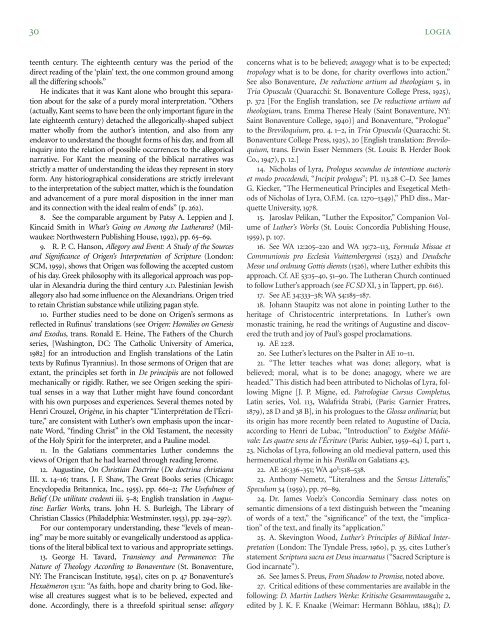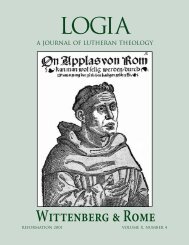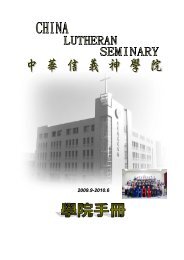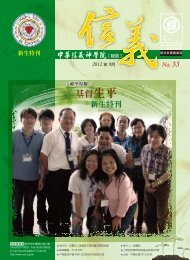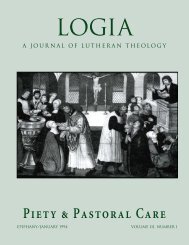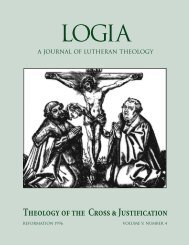04-2 Hermeneutics.pdf
04-2 Hermeneutics.pdf
04-2 Hermeneutics.pdf
- No tags were found...
You also want an ePaper? Increase the reach of your titles
YUMPU automatically turns print PDFs into web optimized ePapers that Google loves.
30 LOGIAteenth century. The eighteenth century was the period of thedirect reading of the ‘plain’ text, the one common ground amongall the differing schools.”He indicates that it was Kant alone who brought this separationabout for the sake of a purely moral interpretation. “Others(actually, Kant seems to have been the only important figure in thelate eighteenth century) detached the allegorically-shaped subjectmatter wholly from the author’s intention, and also from anyendeavor to understand the thought forms of his day, and from allinquiry into the relation of possible occurrences to the allegoricalnarrative. For Kant the meaning of the biblical narratives wasstrictly a matter of understanding the ideas they represent in storyform. Any historiographical considerations are strictly irrelevantto the interpretation of the subject matter, which is the foundationand advancement of a pure moral disposition in the inner manand its connection with the ideal realm of ends” (p. 262).8. See the comparable argument by Patsy A. Leppien and J.Kincaid Smith in What’s Going on Among the Lutherans? (Milwaukee:Northwestern Publishing House, 1992), pp. 65–69.9. R. P. C. Hanson, Allegory and Event: A Study of the Sourcesand Significance of Origen’s Interpretation of Scripture (London:SCM, 1959), shows that Origen was following the accepted customof his day. Greek philosophy with its allegorical approach was popularin Alexandria during the third century A.D. Palestinian Jewishallegory also had some influence on the Alexandrians. Origen triedto retain Christian substance while utilizing pagan style.10. Further studies need to be done on Origen’s sermons asreflected in Rufinus’ translations (see Origen: Homilies on Genesisand Exodus, trans. Ronald E. Heine, The Fathers of the Churchseries, [Washington, DC: The Catholic University of America,1982] for an introduction and English translations of the Latintexts by Rufinus Tyrannius). In those sermons of Origen that areextant, the principles set forth in De principiis are not followedmechanically or rigidly. Rather, we see Origen seeking the spiritualsenses in a way that Luther might have found concordantwith his own purposes and experiences. Several themes noted byHenri Crouzel, Origène, in his chapter “L’interprétation de l’Écriture,”are consistent with Luther’s own emphasis upon the incarnateWord, “finding Christ” in the Old Testament, the necessityof the Holy Spirit for the interpreter, and a Pauline model.11. In the Galatians commentaries Luther condemns theviews of Origen that he had learned through reading Jerome.12. Augustine, On Christian Doctrine (De doctrina christianaIII. x. 14–16; trans. J. F. Shaw, The Great Books series (Chicago:Encyclopedia Britannica, Inc., 1955), pp. 661–2; The Usefulness ofBelief (De utilitate credenti iii. 5–8; English translation in Augustine:Earlier Works, trans. John H. S. Burleigh, The Library ofChristian Classics (Philadelphia: Westminster, 1953), pp. 294–297).For our contemporary understanding, these “levels of meaning”may be more suitably or evangelically understood as applicationsof the literal biblical text to various and appropriate settings.13. George H. Tavard, Transiency and Permanence: TheNature of Theology According to Bonaventure (St. Bonaventure,NY: The Franciscan Institute, 1954), cites on p. 47 Bonaventure’sHexaëmeron 13:11: “As faith, hope and charity bring to God, likewiseall creatures suggest what is to be believed, expected anddone. Accordingly, there is a threefold spiritual sense: allegoryconcerns what is to be believed; anagogy what is to be expected;tropology what is to be done, for charity overflows into action.”See also Bonaventure, De reductione artium ad theologiam 5, inTria Opuscula (Quaracchi: St. Bonaventure College Press, 1925),p. 372 [For the English translation, see De reductione artium adtheologiam, trans. Emma Therese Healy (Saint Bonaventure, NY:Saint Bonaventure College, 1940)] and Bonaventure, “Prologue”to the Breviloquium, pro. 4. 1–2, in Tria Opuscula (Quaracchi: St.Bonaventure College Press, 1925), 20 [English translation: Breviloquium,trans. Erwin Esser Nemmers (St. Louis: B. Herder BookCo., 1947), p. 12.]14. Nicholas of Lyra, Prologus secundus de intentione auctoriset modo procedendi, “Incipit prologus”; PL 113.28 C–D. See JamesG. Kiecker, “The Hermeneutical Principles and Exegetical Methodsof Nicholas of Lyra, O.F.M. (ca. 1270–1349),” PhD diss., MarquetteUniversity, 1978.15. Jaroslav Pelikan, “Luther the Expositor,” Companion Volumeof Luther’s Works (St. Louis: Concordia Publishing House,1959), p. 107.16. See WA 12:205–220 and WA 19:72–113, Formula Missae etCommunionis pro Ecclesia Vuittembergensi (1523) and DeudscheMesse und ordnung Gottis diensts (1526), where Luther exhibits thisapproach. Cf. AE 53:15–40, 51–90. The Lutheran Church continuedto follow Luther’s approach (see FC SD XI, 3 in Tappert, pp. 616).17. See AE 34:333–38; WA 54:185–187.18. Johann Staupitz was not alone in pointing Luther to theheritage of Christocentric interpretations. In Luther’s ownmonastic training, he read the writings of Augustine and discoveredthe truth and joy of Paul’s gospel proclamations.19. AE 22:8.20. See Luther’s lectures on the Psalter in AE 10–11.21. “The letter teaches what was done; allegory, what isbelieved; moral, what is to be done; anagogy, where we areheaded.” This distich had been attributed to Nicholas of Lyra, followingMigne [J. P. Migne, ed. Patrologiae Cursus Completus,Latin series, Vol. 113, Walafrida Strabi, (Paris: Garnier Fratres,1879), 28 D and 38 B], in his prologues to the Glossa ordinaria; butits origin has more recently been related to Augustine of Dacia,according to Henri de Lubac, “Introduction” to Exégèse Médiévale:Les quatre sens de l’Écriture (Paris: Aubier, 1959–64) I, part 1,23. Nicholas of Lyra, following an old medieval pattern, used thishermeneutical rhyme in his Postilla on Galatians 4:3.22. AE 26:336–351; WA 40 1 :518–538.23. Anthony Nemetz, “Literalness and the Sensus Litteralis,”Speculum 34 (1959), pp. 76–89.24. Dr. James Voelz’s Concordia Seminary class notes onsemantic dimensions of a text distinguish between the “meaningof words of a text,” the “significance” of the text, the “implication”of the text, and finally its “application.”25. A. Skevington Wood, Luther’s Principles of Biblical Interpretation(London: The Tyndale Press, 1960), p. 35, cites Luther’sstatement Scriptura sacra est Deus incarnatus (“Sacred Scripture isGod incarnate”).26. See James S. Preus, From Shadow to Promise, noted above.27. Critical editions of these commentaries are available in thefollowing: D. Martin Luthers Werke: Kritische Gesammtausgabe 2,edited by J. K. F. Knaake (Weimar: Hermann Böhlau, 1884); D.


